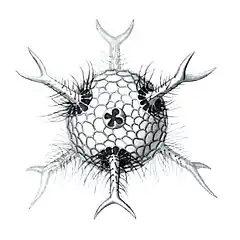| Sun animalcules | |
|---|---|
 | |
| Heliozoan depicted by Louis Joblot, 1718 | |
| Scientific classification (obsolete) | |
| Domain: | |
| Phylum: | |
| Class: | Actinopoda |
| Order: | Heliozoa Haeckel, 1866 |
Heliozoa, commonly known as sun-animalcules, are microbial eukaryotes (protists) with stiff arms (axopodia) radiating from their spherical bodies, which are responsible for their common name.[1][2][3] The axopodia are microtubule-supported projections from the amoeboid cell body, and are variously used for capturing food, sensation, movement, and attachment. They are similar to Radiolaria, but they are distinguished from them by lacking central capsules and other complex skeletal elements, although some produce simple scales and spines.[4] They may be found in both freshwater and marine environments.
Classification
Originally the heliozoa were treated together as a formal taxon Heliozoa or Heliozoea, with the rank of class or phylum, but it has been realised that they are polyphyletic, as the various orders show notable differences and are no longer believed to be descended from a single common ancestor. Instead, "heliozoa" is regarded as a descriptive term applying to various lines of protists.
The primary groups include:[5]
- Actinophryida, Pedinellida and Ciliophryida (currently in Stramenopiles)
- Centrohelida (some support for Hacrobia)
- Desmothoracida, Heliomonadida/Dimorphida and Gymnosphaerida (currently in Rhizaria > Cercozoa)
- Taxopodida/Sticholonche (currently in Rhizaria > Radiolaria)
- Rotosphaerida (currently in Opisthokonta > Nucleariida and in Rhizaria)[6]
Several nucleariids were once considered heliozoa, but they do not have microtubule-supported axopods and so are now considered filose amoeboids instead.
Phylogeny
The heliozoa are a polyphyletic grouping of various protists that have independently evolved axopodial arms. Some of the heliozoan groups are intermingled in the supergroup Rhizaria with radiolarians, their mostly marine counterpart.[5]
| Eukaryotes |
| |||||||||||||||||||||||||||||||||||||||||||||||||||||||||||||||
References
- ↑ Cavalier-Smith T, von der Heyden S (September 2007). "Molecular phylogeny, scale evolution and taxonomy of centrohelid heliozoa". Mol. Phylogenet. Evol. 44 (3): 1186–203. doi:10.1016/j.ympev.2007.04.019. PMID 17588778.
- ↑ "Sarcodia". Retrieved 28 August 2014.
- ↑ D.J. Patterson (1996). Free-living freshwater Protozoa. ASM Press. p. 168.
- ↑ Cavalier-Smith, Thomas (December 1993). "Kingdom Protozoa and its 18 phyla". Microbiological Reviews. 57 (4): 953–994. doi:10.1128/mmbr.57.4.953-994.1993. PMC 372943. PMID 8302218.
- 1 2 Nikolaev SI, Berney C, Fahrni JF, et al. (May 2004). "The twilight of Heliozoa and rise of Rhizaria, an emerging supergroup of amoeboid eukaryotes". Proc. Natl. Acad. Sci. U.S.A. 101 (21): 8066–71. doi:10.1073/pnas.0308602101. PMC 419558. PMID 15148395.
- ↑ Cavalier-Smith, Thomas; Chao, Ema E. (2012). "Oxnerella micra sp. n. (Oxnerellidae fam. n.), a Tiny Naked Centrohelid, and the Diversity and Evolution of Heliozoa". Protist. 163 (4): 574–601. doi:10.1016/j.protis.2011.12.005. PMID 22317961.
External links
- Actinosphaerium (single-celled) is an example of a heliozoa. For an image see http://www.microscopy-uk.org.uk/index.html?http://www.microscopy-uk.org.uk/ponddip/
- . Encyclopædia Britannica (11th ed.). 1911.


%252C_Haeckel_(28187768550).jpg.webp)
